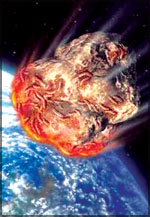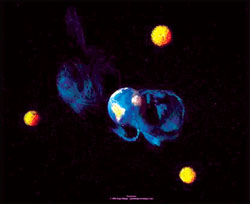Meteors that carry life forms
 Generally,
when we think of how certain complex things happen, we tend to think of
complex ways to explain it. Generally,
when we think of how certain complex things happen, we tend to think of
complex ways to explain it. But, these complex issues may sometimes have very simple explanations.
But, these complex issues may sometimes have very simple explanations.
The topic that we are going to discuss today is also such a concept.
Here is something exciting for you to think about. Have you ever
thought of ways how life can move between planets, apart from the belief
you have about using space ships and some other alien gateway? How about
thinking of the ability of life to travel between planets using meteors
as vehicles?
Going by the various experiments being carried out, this concept is
pretty exciting. Even certain scientists believe that life on Earth came
from a different world, packed in a meteor.
A lot of tests have been done on this subject, and scientists are
revealing interesting information. So meteorites, while they can be
destructive to life when they hit the Earth, can also create new
opportunities for life to continue after an impact.
How can this happen?
Scientists have revealed that there is a possibility for life to
travel on meteors to other planets. For your
 information,
the theory of life travelling between worlds is known as Panspermia. information,
the theory of life travelling between worlds is known as Panspermia.
Just imagine a situation where a meteor strikes a planet and pieces
of that planet flying into space as a result of the impact. It may not
be a very large piece of the planet, but even a tiny piece of rock can
jump into space in a collision between a meteor and a planet. These
pieces can be attracted by another planet by its gravitational pull and
these pieces would become meteors for that planet.
You may be aware that Earth has been struck by many meteors from
outer space which are believed to be mostly from the Moon or Mars. In
certain big collisions Earth had with meteors, pieces from Earth could
have flown in to outer space and landed on our neighbouring planets.
No one can say no to this possibility. Certain scientists believe
that life on Earth could have originated on Mars or even a planet
further away and then brought to Earth by a meteorite.
Experiments
Scientists and astrobiologists are experimenting a lot on this
concept under various aspects right now. When we talk of life, it need not be about just big creatures. Micro-organisms
like bacteria are considered to be forms of life who can survive under
extreme conditions.
talk of life, it need not be about just big creatures. Micro-organisms
like bacteria are considered to be forms of life who can survive under
extreme conditions.
Since they are so tiny, they can easily reside in any crack or on the
surface of even a small meteor. But, there are many instances where they
would have to face rigorous conditions.
According to a news item that appeared on the internet, Charles
Cockell, a microbiologist at the Open University in the UK who was
involved in this study has stated that, these organisms will have to
survive atmospheric, the conditions in space, and also atmospheric
re-entry when they reach the destination planet.
Scientists have experimented how bacterial spores (think of these as
eggs of bacteria) can withstand the huge stress when they are driven out
of a planet. They have found out that bacterial spores can withstand
over one million G forces. G force is a measure of force.
 You
need not think of the exact meaning right now. They have also put
bacterial spores in to bullets and shot them in to sand to find out how
they survive under impacts. This has revealed that the shock has not
killed the spores and they can survive high impacts. You
need not think of the exact meaning right now. They have also put
bacterial spores in to bullets and shot them in to sand to find out how
they survive under impacts. This has revealed that the shock has not
killed the spores and they can survive high impacts.
This result has shown that bacteria has a big chance of surviving
when the meteor lands on the planet. Further experiments have been done
to check how micro-organisms can face shock pressures. For this,
micro-organisms have been put between two plates and a small explosion
has been done to shock the plates together. The microbes had survived.
This has made clear that certain micro-organisms can withstand the
heavy pressure of being ejected from the planet as well as the impact of
landing.
But, they still have to experiment how these organisms would survive
during the journey in outer space.
The most important concern is how the organisms would withstand the
immense heat generated during entering a planet's atmosphere. One idea is to have the bacteria or whatever
micro- organism inside the meteor, so that they would get less affected
by the heat. But, still this is considered to be a strong barrier in
spreading micro-organisms among planets.
a planet's atmosphere. One idea is to have the bacteria or whatever
micro- organism inside the meteor, so that they would get less affected
by the heat. But, still this is considered to be a strong barrier in
spreading micro-organisms among planets.
Aravinda Dassanayake |
